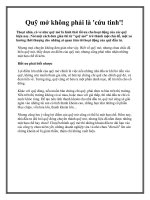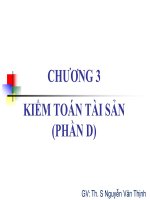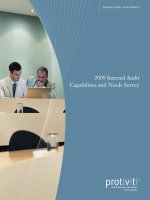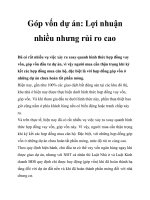VALENTIN IOAN UŞURELU, MIOARA MARIN (NEDELCU), ALINA ELENA DANAILĂ (ANDREI), DANIELA LOGHIN * pot
Bạn đang xem bản rút gọn của tài liệu. Xem và tải ngay bản đầy đủ của tài liệu tại đây (206.21 KB, 8 trang )
Annals of the University of Petroşani, Economics, 10(3), 2010, 349-356 349
ACCOUNTING ETHICS - RESPONSIBILITY VERSUS
CREATIVITY
VALENTIN IOAN UŞURELU, MIOARA MARIN (NEDELCU),
ALINA ELENA DANAILĂ (ANDREI),
DANIELA LOGHIN
*
ABSTRACT: Professional accountants are ordered in some point in their life to take
certain decisions that are ethical or not. Accounting ethics is an important aspect of an
accountant's work. In the last decades has increased so much interest in accounting ethics so
that the financial statements should be prepared to come to include a descriptive report of
accounting professionals who have created and filled these situations. This report should
include any information considered relevant about factors that influence ethical behaviour. The
present research aims to show what is accounting ethics, what is the purpose of the National
Code of Ethics for Professional Accountants of Romania, what is creative accounting and
ethical behaviour that depends on an accountant, what are the reasons for the use of creative
accounting and also what are its main practices.
KEY WORDS: accounting ethics,
responsibility, creative accounting, ethical
behaviour, code of ethics
JEL CLASSIFICATION: M41
1. INTRODUCTION
Ethics is all rules of conduct shared by a particular community, rules that are
based on the distinction between good and evil. Morality is all the principles of
universal normative dimension (often dogmatic), based on the distinction between
good and evil (Wundenburger, 1993, p. XIV). Professional ethics is recognized as a
science which deals with the study of professionals in meeting the obligations and
rights of their professional activities. Professional ethics is a reflective and critical
*
Ph.D. Student, “Valahia” University of Târgovişte, Romania,
Ph.D. Student, “Valahia” University of Târgovişte, Romania,
Ph.D. Student, “Valahia” University of Târgovişte, Romania,
Ph.D. Student, “Valahia” University of Târgovişte, Romania,
350 Uşurelu, V.I.; Marin (Nedelcu), M.; Danailă (Andrei), A.E.; Loghin, D.
discipline. It is located at the intersection of moral philosophy with particular ethics of
various categories of occupations. The central issue of the introduction of ethics in
professions, although there are already laws is because the law usually acts after an
infringement has occurred. Border and ethical practices are believed to act preventively
(Airaksinen, 1998, pp 671-672).
Luca Pacioli, the "Father of Accounting", wrote on
accounting ethics in his first book Summa de arithmetica, geometria, proportioni, et
proportionalita, published in 1494.
Ethical standards have since then been developed
through government groups, professional organizations, and independent companies.
These various groups have led accountants to follow several codes of ethics to perform
their duties in a professional work environment. Accountants must follow the code of
ethics set out by the professional body of which they are a member.
Creative accounting provides a formidable challenge for the accounting
profession. The problem is an international one, accounting policies choice being a
particular problem for the Anglo-American tradition and handling transactions is a
particular problem for the continental European tradition. There is a variety of
managers’ motivation for creative accounting practices. Accountants who accept the
ethical challenge of creative accounting must be aware of the abuse in the choice of
accounting practices and handling transactions.
2. NATIONAL CODE OF ETHICS FOR PROFESSIONAL ACCOUNTANTS
OF ROMANIA
The national Code of Ethics for Professional Accountants of Romania
establishes rules of conduct for professional accountants and formulates basic
principles to be followed by professional accountants to achieve common goals.
Romania accountants and entities operating in different sectors of national economy as
freelancers or as employees; basic purpose of the Code, but must always be respected.
National Code of Ethics for Professional Accountants of Romania is divided
into three parts. Part A establishes the fundamental principles of professional ethics for
professional accountants and provides a conceptual framework for applying these
principles. Conceptual framework provides guidance on fundamental ethical principles.
Professional accountants are required to apply this conceptual framework to identify
threats to compliance with the fundamental principles in assessing their significance
and if these threats are other than clearly insignificant to apply safeguards to eliminate
or reduce to an acceptable level so as not to be compromised compliance with
fundamental principles. Parts B and C illustrates how the conceptual framework should
be applied in specific situations.
They provide examples of safeguards that might be appropriate to address
threats to compliance with the fundamental principles and also provides examples of
situations where safeguards are not available to address threats and therefore, activity
or relationship that creates threats should be avoided. Part B addresses to independent
professional accountants. Part C applies to employed professional accountants.
Independent accounting professionals may also find guidance on their specific
situations, in Part C.
Accounting Ethics - Responsibility versus Creativity 351
Code recognizes that accounting profession objectives are established to meet
the highest standards of professionalism, to achieve the highest levels of performance
and meet the public interest. Achieving these goals involves meeting four basic
requirements:
- Credibility. Throughout society there is need for credibility in information
and information systems.
- Professionalism. There is a need for customers, employers and other
stakeholders can be clearly identified those accounting professionals.
- Service quality. It requires ensuring that all services obtained from the
professional accountant are carried to the highest standard of performance.
- Confidence. Professional accountants service users must be able to feel
confident that there is a framework of professional ethics governing the
provision of those services.
Circumstances in which professional accountants operate may allow the
emergence of threats to compliance with fundamental principles. It's impossible to
define every situation that leaves such threats and specific measures to be taken to
mitigate them. Moreover, the nature of tasks and assignments can vary, therefore there
may be different threats that require the application of other protective measures. Code
offers a general framework that can assist the professional accountant to identify,
assess and overcome these threats in accordance with fundamental principles. If
identified threats are other than clearly insignificant, a professional accountant should,
where appropriate, apply safeguards to eliminate or reduce to an acceptable level so
that compliance with fundamental principles not to be compromised.
A professional accountant should respect the following basic principles:
(a) Integrity. A professional accountant should be straight and honest in all
professional and business relationships.
(b) Objectivity. A professional accountant should be impartial and must not
allow prejudice, confusion, conflicts of interest and unwanted influence to interfere
with professional or business judgments.
(c) Professional competence and prudence. A professional accountant has a
continuing duty to maintain knowledge and skill level necessary to ensure that a client
or employer receives competent professional service based on the latest developments
in practical. A professional accountant should act with caution and in accordance with
applicable technical and professional standards in providing professional services.
(d) Privacy. A professional accountant should respect the confidentiality of
information acquired as a result of professional or business relationship and should not
disclose such information to any third party without specific authorization, unless there
is a right. Confidential information obtained in a professional or business relationships
should not be used for personal advantage of the professional accountant or third
parties.
(e) Professional behavior. A professional accountant should comply with
relevant laws and regulations and should avoid any action that can discredit the
profession.
(f) Respect for technical and professional standards. Professional accountant
should carry out professional duties in accordance with relevant technical and
352 Uşurelu, V.I.; Marin (Nedelcu), M.; Danailă (Andrei), A.E.; Loghin, D.
professional. Professional accountants have a duty to perform with skill and care
instructions provided to the client or employer that are compatible with the
requirements of integrity, objectivity and, if self-employed accountants, with
independence. In addition, they must comply with professional and technical standards
issued by: IFAC, IASB CECCAR, CAFR and relevant legislation.
3. THE ETHICS OF ACCOUNTANTS AND THE CREATIVE ACCOUNTING
Accountants can use their knowledge of accounting rules to manipulate the
figures reported in the accounts of a business. The term creative accounting is widely
used to describe accepted accounting techniques which permit corporations to report
financial results that may not accurately portray the substance of their business
activities creative accounting is recognized as a synonym for deceptive accounting.
A vision concerning accounting engineering, but also the most complex is exposed by
Naser, considering it: “1) the process by which, given the existence of some gaps in the
rules, the accounting figures are manipulated and by taking advantage of the flexibility,
there are chosen those measurement and information practices that allow the
transformation of the summaries of what it should be in what managers want; 2) the
process by which transactions are structured in such a way to allow the “production” of
the desired accounting result” (Naser, 1993, pp . 59).
Creative accounting methods are noteworthy because they remain in use as
generally accepted accounting principles, even though they have been shown to be
deceptive in many cases (Metcalf, 1977, pp. 188). Every company in the country is
fiddling its profits. Every set of published accounts is based on books which have been
gently cooked or completely roasted this deception is all in perfectly good taste. It is
legitimate. It is creative accounting. (Griffiths, 1992, pp. 1)
As IFRS 1 ‘The financial statements’ reporting’ in order to bring out and to
present the right financial information, the following conditions have to be taken into
account:
- The concordance with IFRS stipulations;
- The possibility to depart from IFRS, if according to the stipulation the
right information is not obtained;
- The reporting of additional information in order to present a complete
image of transactions and events.
Generally, the creative accounting is badly treated, as a negative creation,
designed to prepare the financial statements in order to respond managers’
requirements regarding the company’s financial position and performance. Therefore,
the financial statements are rather a misrepresentation of the company’s performance
that a true reporting. (Balaciu & Pop, 2008, pp. 935-940)
In line with the Aristotelian tradition, Mele´ (2005, pp.97-109) suggests ethical
behavior of a person in accounting, as in any other human activity, depends on:
Moral sensitivity, which could be described as how the subject comprehends
the ethical dimension of a situation. Human beings have a certain capacity to feel
other’s people needs. In the face of certain situations we experience feelings of
compassion, solidarity, sympathy for a noble cause, and other moral sentiments. In
Accounting Ethics - Responsibility versus Creativity 353
accounting, one can feel that a practice can adversely or favorably affects some people.
But there are also sentiments of greed, self-sufficiency or even fear which can be
stronger than those related to good behavior. Sentiments can also lead to attitudes of
sentimentalism, the morality of which could be questioned.
Moral judgment, or capacity to judge which alternatives are ethically
acceptable and which are not and to determine the uprightness of the intention. Good
behavior requires deliberation and deciding to carry out an action. Making sound moral
judgments is previous to making a good decision. In this deliberation, practical wisdom
plays a crucial role. It fosters upright moral reasoning by taking into account universal
principles and the pertinent circumstances of each situation. Furthermore, some other
relevant virtues in accounting, such as objectivity, open-mindedness, insight and
perspicacity can be considered as integrated within practical wisdom.
Moral motivation, understood as willingness to take the moral course of action,
placing moral values (human goods) above other values, and taking personal
responsibility for moral outcomes. Frequently, moral motivation is the driving force for
making good moral judgments but it plays a crucial role in selecting the right action
and in executing it. Practical wisdom and transitive moral virtues foster moral
motivation, since they give a permanent motivation for acting well.
Moral virtues or permanent attitudes and interior strength for moral behavior.
Among these virtues, those which have special relevance to accounting are fairness,
integrity, truthfulness, honesty, loyalty, faithfulness, trustworthiness, service to the
common good, gratitude and benevolence. Courage, perseverance, competence,
diligence, professional will, humility, and other self-mastering virtues which help to
defeat inner resistance to act as one should. Practical wisdom, as has been said,
provides capacity to perceive the right means for each virtue.
Discussions of creative accounting have focused mainly on the impact on
decision of investors in the stock market. Reasons for the directors of listed companies
to seek to manipulate the accounts are as follows (Amat et. al., 2009):
a) Income smoothing. Companies generally prefer to report a steady trend of
growth in profit rather than to show volatile profits with a series of dramatic rises and
falls. This is achieved by making unnecessarily high provisions for liabilities and
against asset values in good years so that these provisions can be reduced, thereby
improving reported profits, in bad years. Advocates of this approach argue that it is a
measure against the 'short-termism' of judging an investment on the basis of the yields
achieved in the immediate following years. It also avoids raising expectations so high
in good years that the company is unable to deliver what is required subsequently.
b) A variant on income smoothing is to manipulate profit to tie in to
forecasts. Fox (1997) reports on how accounting policies at Microsoft are designed,
within the normal accounting rules, to match reported earnings to profit forecasts.
When Microsoft sell software a large part of the profit is deferred to future years to
cover potential upgrade and customer support costs. This perfectly respectable, and
highly conservative, accounting policy means that future earnings are easy to predict.
c) Company directors may keep an income-boosting accounting policy
change in hand to distract attention from unwelcome news.
354 Uşurelu, V.I.; Marin (Nedelcu), M.; Danailă (Andrei), A.E.; Loghin, D.
d) Creative accounting may help maintain or boost the share price both by
reducing the apparent levels of borrowing, so making the company appear subject to
less risk, and by creating the appearance of a good profit trend. This helps the company
to raise capital from new share issues, offer their own shares in takeover bids, and
resist takeover by other companies.
e) If the directors engage in 'insider dealing' in their company's shares they
can use creative accounting to delay the release of information for the market, thereby
enhancing their opportunity to benefit from inside knowledge.
4. CREATIVE ACCOUNTING PRACTICES
In order to tell if an enterprise uses one or more creative accounting practices,
it is necessary to make a classification of these practices. Thus, according to Raileanu
and al. (2010, pp. 12-14), such a classification is based on the revenue, expenses, assets
and liabilities. To these are added creative practices used in the preparation of profit
and loss account and cash flow statement. Specifically, this classification refers to:
- Recognition of premature or fictitious revenue;
- Policies of aggressive capitalization and extended amortization periods
of use;
- Inaccurate reporting of assets and liabilities;
- Creativity manifested in the profit and loss account;
- Issues related to reporting cash flows.
a) Recognition of premature revenue means recognition of real sales revenues
at an earlier date than that which would have been used. It is the case of companies that
receive commissions that refers to an extended period, but which is early recognized.
Recognition of fictitious revenue involves the registration of some inexistent sales
incomes.
b) Policies of aggressive capitalization and extended amortization periods of
use. Unlike enterprises that improve their results by increasing revenue, some
companies increase their result by minimizing costs. They minimize their costs by
aggressive capitalization of costs that should affect the profit and loss account also by
depreciating amounts for extended periods. There are cases where expenditure to be
capitalized is not easily determined and thus, it is recommended to appeal to
professional judgment in order to determine whether or not capitalization is required.
These are items such as software development costs, advertising costs and
development costs. When an expense is capitalized, it is created an asset to be
amortized over its useful life period, so the influence on the result is positive. Also,
another practice to reduce costs and increase the result is one of using extended
amortization periods for previously capitalized costs.
c) Inaccurate reporting of assets and liabilities. In this category are included
assets not submitted to amortization such as receivables, inventories and investments.
By overestimating the degree of collection of receivables, it is reduced an operating
expense. There is also the possibility that a loss to be deferred: in the case of stocks or
investment, companies do not diminish their value as a result of lower market price.
Also, in this category are included the understatement share of debt.
Accounting Ethics - Responsibility versus Creativity 355
d) Creativity manifested in the profit and loss account involves presenting
different levels of income components, focusing more on the classification of elements
than their manner of recording transactions. For example, enterprises can have a
tremendous benefit in the “other income” category or a current operating expense as
being extraordinary. The consequence of such practices has apparently higher current
results, without being affected overall net result.
e) Issues related to reporting cash flows. The cash flow statement divides
changes in cash and cash equivalents in three components: cash flows from or used in
operating activities, investment and financing. Given the importance of cash flow from
operating activities, the higher their level is, the company’s ability to generate
sustainable results is higher.
To increase its operating cash flow, companies can classify an operating
expenditure as an item of investment or financing. Similarly, a collection of investment
or financing activities may be classified as an operating item. Such actions will not
affect the total changes in cash flows. For example, companies that capitalize software
development costs will report the capitalized amounts as payments related to
investment and not operating activities. So a company that capitalizes a greater share of
costs will provide a higher operating cash flow value than enterprises that expense all
software development costs.
5. CONCLUSIONS
Creative accounting offers a formidable challenge to the accounting
profession. Professional accountants need an education that would ensure the specific
application knowledge necessary to practice accounting ethics and morals. To be
considered ethical, accounting practice should include not only compliance with
specific rules and laws. The process of being ethical has to include the process of
interpreting the underlying motives and theories. To be truly ethical, professional
accountant must know why certain actions are good and others are bad.
In order to be able to do that, it is essential to develop values and virtues. Since
values provide a stimulus to act in a certain manner, and virtues are permanent
dispositions promoting ethical behaviour, combined together can shape characters.
This allows accountants to resist negative pressures of the environment, and permits
them to make moral decisions.
Also, knowing the rules does not give one an answer for every type of
situation. They exist to provide guidelines, but because circumstances vary, there never
is one answer. Therefore, values and virtues combined with rules give accountants
enough insight to make a judgment. A full ethics education to link the ethical values
and moral virtues of accountants with applicable laws, requires that financial
statements drawn up to include a descriptive report of accounting professionals who
have created and filled these situations. This report should include any information
considered relevant about factors that influence ethical behaviour.
A solution to limit creative accounting practice would be imposing a
regulatory accounting system which would strengthen accounting standards.
356 Uşurelu, V.I.; Marin (Nedelcu), M.; Danailă (Andrei), A.E.; Loghin, D.
REFERENCES:
[1]. Amat, O.; Blake, J.; Dowds, J. (2009) The ethics of creative accounting, available online
at:
retrieved at 1.10.2010
[2]. Airaksinen, T. (1998) Professional Ethics, în Encyclopedia of Applied Ethics, 3,
Academic Press, pp.671-682
[3]. Balaciu, D.; Pop, C.M. (2008) Is creative accounting a form of manipulation?, „Analele
Universităţii din Oradea”, seria Ştiinţe Economice, Volumul III, Sectiunea: Finante,
Banci si Contabilitate, Tom XVII, pp.35-940
[4]. Griffiths, I. (1992) Creative Accounting: How to make your profits what you want them to
be (London: Routledge, First published in 1986)
[5].
Melé, D. (2005) Ethical Education in Accounting: Integrating Rules, Values and Virtues,
Journal of Business Ethics, 57, pp.97-109
[6]. Metcalf, L. (1977) The Accounting Establishment, Staff study as the Chairman of the US
Senate Subcommittee (Washington, D.C.: The United States Government Printing
Office)
[7]. Naser, K. (1993) Creative financial accounting: its nature and use, Hemel Hempstead:
Prentice Hall
[8]. Raileanu, V.; Manea, C.L.; Rapcencu, C. (2010) Contabilitatea creativa – note de curs,
available online at: />%20Suport%20curs%20contabilitate%20creativa%202009-2010.pdf, retrieved at 1.10.
2010
[9]. Wundenburger, J.J. (1993) Questions d' éthique, Presses Universitaires de France
[10]. CECCAR (2007) Codul etic national al profesionistilor contabili (editia a IV-a,
revizuita), Editura CECCAR









